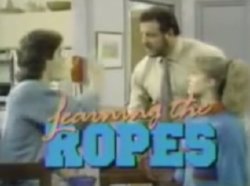Learning The Ropes came and went without much of a ripple back in the fall of 1988, but it remains the one and only sitcom that ever made the airwaves about professional wrestling. Let’s look back on it, as a compliment to Bob Kapur’s excellent interview with Nicole Stoffman.
Alas, since it is not available on DVD, we need to get our memories stirred up. YouTube has a few clips, and the opening segment in particular is a tribute to the 1980s, with its bright colours and hokey premise of a high school teacher and vice-principal who moonlights as a pro wrestler named the Masked Maniac.
It starred retired football star Lyle Alzado as Robert Randall, in his first leading role, and he was ably backed up by his storyline kids, Yannick Bisson and Nicole Stoffman, both of whom were veterans of the Canadian TV landscape despite their young ages.

The Canadian Wrestling Report (written by some teenager named Greg Oliver) wrote about the show in January 1988: “Now the NWA and Jim Crockett Promotions certainly has made a major breakthrough with this deal. The NWA will basically be getting national (Canadian) television exposure for their stars.”
Producers Group International were behind the show, and Dennis O’Neill and his wife, Jill Keenleyside were the people leading the charge. Having worked on The Frantics’ series Four on the Floor, and on many Canadian movies and TV shows, the Canadian aspect was not a key to Learning The Ropes getting made, O’Neill said in 1998.
“With Learning The Ropes, the Canadian sale was really the tail of the dog,” he told Tony Atherton of the Ottawa Citizen, explaining that the idea was brought to them by an American syndicator. The show was shot at the CTV studios in Toronto, and from what we can establish, was the last sitcom that CTV was directly involved in being a part of, and it was filmed at a vacant Canada Tire plant on Sheppard Ave. E., in Toronto’s northeast end.
The same story said that the show — pitched in a press release as “a judicious mixture of family programming and popular sports entertainment” — reached about 85 per cent of the U.S. markets through syndication. It was never picked up by a U.S. network.
Stoffman talked about the actual taping of the show: “It had a theatrical aspect since we recorded live once a week. Then we got to interact with the live studio audience. That wasn’t the version that went to air. There would be a reshoot of some necessary parts.” The writers and the direction of the show changed part-way through its run.
The Canadian Wrestling Report gave the show a review in its December 1988 issue: “The show, starring Lyle Alzado, is loosely based around pro wrestling and features many stars of the NWA (past and present!). This is why we’re talking about it. I really enjoy the show, not because of the intended humour or the fact that it’s a Canadian production. The wrestlers that are featured each week really make the show. Stan Lane, of the Midnight Express, did more talking in one show than he and Bobby [Eaton] have ever done with Jim Cornette around. … It may not be totally realistic, at school, or at the arena, but hey, it’s Willowdale, Ontario — not Hollywood, California!”
Other reviewers were not so kind, or so excited about the tie-in to the NWA with stars such as Ric Flair, Tully Blanchard, the Road Warriors and Jimmy Garvin appearing.
“In the episode I saw, Lyle substituted for the son’s biology teacher, leading the latter to think he and his buddies could slack off. Why was he so surprised when that didn’t happen? If I were Lyle, I’d have body-slammed sonny boy after the first wisecrack, but then if I were Lyle I wouldn’t have gotten into this series. Alzado is still an amateurish actor with a wooden style,” wrote Greg Burliuk in the Kingston Whig-Standard. “So what’s so good about this show? Answer: the locker-room segments, in which real wrestlers are used. To be in wrestling these guys have to be natural hams and they make the most of their lines, even though they’re made out to look like dumb animals. If Lyle could lose the kids and go bowling with the boys, this show would be a real winner.”
In the publicity rounds for the show, the 6-foot-3-1/2, 285-pound Alzado found himself defending his acting skills. Alzado was raised in a poor family in Brooklyn’s Brownsville neighborhood, six people in the family; he often credited the poverty and tough times as a big part of his drive. He was a fourth-round draft choice of the NFL’s Denver Broncos in 1971, out of the small Yankton College in South Dakota, where he also wrestled amateur. Through his 11 seasons in Denver, Cleveland and Los Angeles Raiders, “Mr. Mean” Alzado was a wild, unpredictable defensive end, that, upon his retirement, one sportswriter called “a belligerent, bearded Hells Angels in cleats.” It was a torn Achilles tendon in his left leg that ended his career.
Alzado always had a colourful side, and acting seemed to fit the bill. He debuted while still playing in the NFL, in 1977’s The Double McGuffin, which starred George Kennedy and Ernest Borgnine. On TV, he’d appear on shows such as The Fall Guy, Riptide and Amazing Stories, and numerous commercials. And we cannot forget his 1984 exercise video: No Sweat – Working Out With Lyle Alzado.
Three seasons removed from football, he got his break with Learning The Ropes, and admitted that he was doing some learning as well.
“This role gives me a greater range to develop my acting ability — develop more depth, foundation and strength,” he told the Associated Press.
In an interview with the Toronto Star, Alzado’s co-star and love interest on the show, Cheryl Wilson, was quick to defend his nascent thespian skills.
“I get so tired of hearing, ‘Oh, he’s just a football player. He can’t act. He’s wooden,'” Wilson told Bill Taylor. “I think people should give it a rest!”
She definitely believed in Alzado’s potential: “He works incredibly hard. He takes it so seriously. He wants to be good. He wants to be respected by his peers and by the entertainment industry. Lyle would be the first person to tell you he’s not Laurence Olivier. But, I swear to God, he’s going to be one of those athletes who makes it big as an actor.”
While Alzado did continue to work in the film and TV industry after Learning The Ropes, a brain tumor killed him at age 43, dying on May 14, 1992. He was one of the first big-name athletes to admit to steroid use and abuse, and always claimed that the tumor was related to his steroid use.
Wilson played Carol Dixon, an art teacher who was in the dark as far as Alzado’s secret life at night. During her career, she had more serious roles on Canadian shows like Night Heat, Diamonds, Seeing Things, The Beachcombers and Hitchcock. Wilson said they were doing the best they could: “I know we’ll never be Cheers, though I’m always trying to make it a tad more sophisticated than it’s destined to be.”
The late Steve “Dr. Death” Williams was Alzado’s stunt double; in other words, he was actually the Masked Maniac. In his autobiography, Williams wrote about the show.
“Lyle needed some real wrestlers to work on his show, as well as a stuntman who looked like him and could absorb the punishment of being in a ring. Several WCW stars appeared on the show, such as Ric Flair, Ronnie Garvin, and the Road Warriors. But Lyle chose ME as his stuntman, and I wrestled in the show as the ‘Masked Maniac,'” explained Williams. “Let me tell you, being a stuntman for the sitcom was one very painful experience. During one stunt, I blew out my knee landing on the canvas of a stiff ring after Ric Flair rolled out of the way. On another occasion, I got my head busted open when Tully Blanchard smashed a steel chair over it. I went to the hospital, got 39 stitches in my head, and quickly returned to the set to finish the session. It was the most painful $2,000 I would ever earn in my lifetime.”
In December 1987, the Chicago Sun-Times asked Flair about working in a TV comedy. The Nature Boy said it was “interesting … I enjoyed it very much. But as long as I can keep wrestling, that’s what I will do.” Naitch has certainly kept his word.
Learning The Ropes ran from September 18, 1988 to March 31, 1989, and 26 episodes were made.
RELATED LINK
- Aug. 11, 2012: Degrassi grad Stoffman loved Learning the Ropes
Greg Oliver attended a taping of Learning The Ropes, but doesn’t remember much about it. If you are interested in his Canadian Wrestling Report newsletters, they are available in PDF format here.
